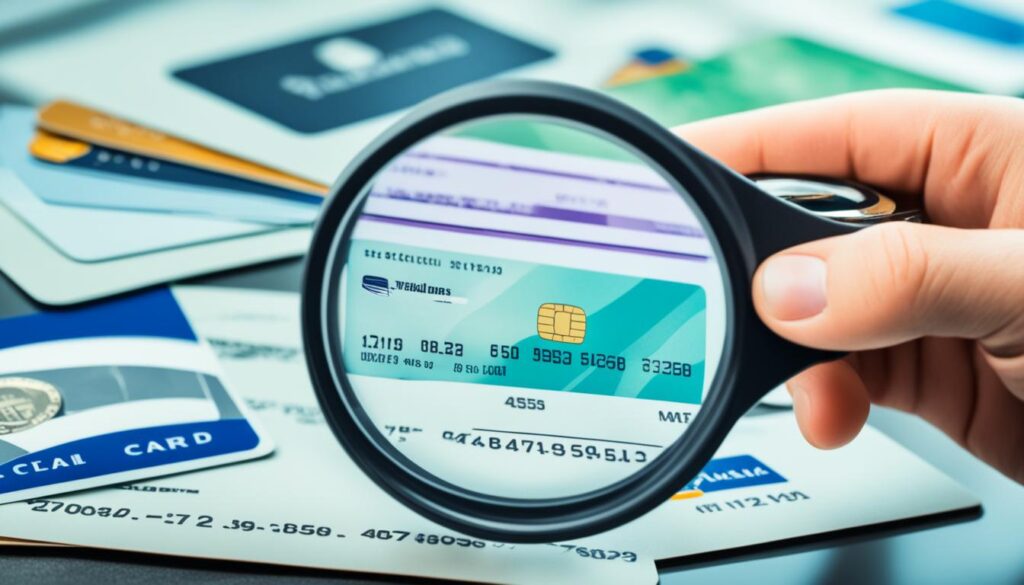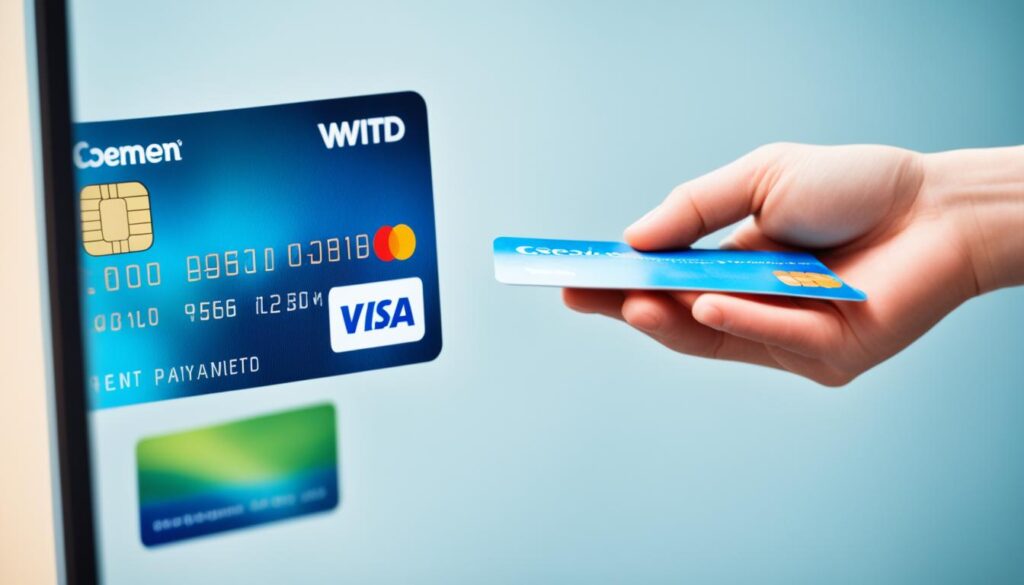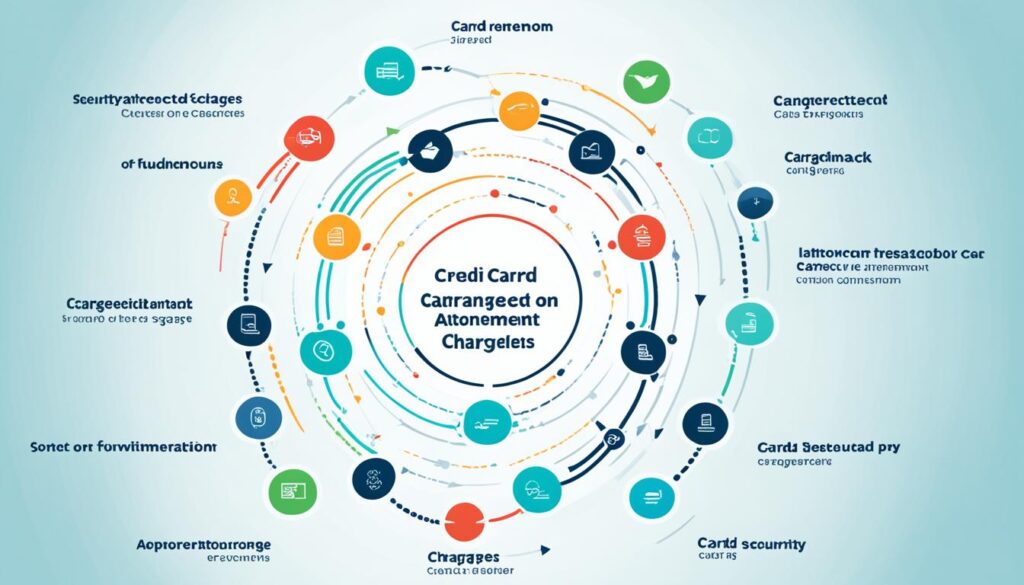Are you aware that small businesses can potentially save thousands of dollars every year by finding ways to reduce processing fees related to card payments?
As a small business owner myself, I understand the importance of cutting costs without compromising the quality of service. In this article, I will share my personal tips and tricks on how to take card payments for free, helping you boost your profitability while providing a seamless payment experience for your customers.
Key Takeaways:
- Choose a credit card processor with a surcharge program to pass the processing cost to customers.
- Verify addresses during checkout to lower credit card fees and reduce fraud.
- Consider giving a cash discount to customers who pay with cash or check.
- Regularly examine your monthly statement to identify and dispute unjustified fees.
- Add service or convenience fees to offset non-processing costs.
Choose a Credit Card Processor with a Surcharge Program
One way to take card payments for free is by choosing a credit card processor that offers a surcharge program. This program allows businesses to pass the credit card processing cost to customers through a checkout fee. However, there are strict rules to follow, such as notifying card networks and informing consumers.
Some credit card processing companies that offer surcharge programs include Helcim, Square, Stax, Heartland Payments, and Elavon.
By leveraging a credit card processor with a surcharge program, you can minimize your card payment processing expenses and improve your bottom line.
Here’s a comparison table of some notable credit card processors with surcharge programs:
| Company | Surcharge Program | Additional Features |
|---|---|---|
| Helcim | Yes | Transparent pricing, advanced reporting |
| Square | Yes | Point-of-sale system, online store integration |
| Stax | Yes | Customizable analytics, risk management tools |
| Heartland Payments | Yes | EMV card processing, mobile payment solutions |
| Elavon | Yes | Virtual terminal, recurring billing |
Make sure to evaluate each credit card processor’s features, pricing structure, and customer support to choose the one that best suits your business needs.
Verify Addresses for Lower Credit Card Fees
Another effective strategy to reduce credit card fees is by implementing an address verification service (AVS) during the checkout process. By utilizing AVS, merchants can minimize fraud and chargebacks, ultimately leading to lower interchange rates offered by Visa.
Address verification service (AVS) involves confirming that the billing address provided by the customer matches the address associated with the credit card. This verification process adds an extra layer of security, ensuring that transactions are legitimate and reducing the likelihood of fraudulent activity.
By conducting an AVS check, merchants can significantly decrease the risk of incurring unnecessary fees associated with chargebacks and dispute resolution. By aligning the cardholder’s billing address with the information provided by the customer, merchants can establish trust and confidence in the transaction, ultimately leading to a lower interchange rate.
Implementing AVS is a straightforward process. Merchants need to integrate their payment gateway with an AVS-capable system during the checkout process. The system will automatically compare the entered billing address with the billing address on file with the card issuer. This helps identify any inconsistencies and allows the merchant to take appropriate actions to prevent potential fraud or chargebacks.
“Implementing an address verification service has been a game-changer for my business. Not only am I able to provide an added layer of security for my customers, but I have also noticed a significant reduction in credit card fees. It’s a win-win situation!” – Sarah Miller, Owner of Miller’s Boutique
In addition to reducing fees, AVS also enhances customer satisfaction by minimizing the risk of unauthorized transactions and protecting their personal information. With the ever-increasing importance of online security, customers appreciate the extra steps taken by merchants to safeguard their financial data. This can result in repeat business and positive word-of-mouth recommendations.

Implementing an address verification service is a proactive measure that can help small businesses save money and streamline their payment processes. By verifying addresses and ensuring transaction security, merchants can enjoy lower credit card fees, increased customer trust, and enhanced profitability.
Give a Cash Discount to Customers
Instead of surcharging, some businesses choose to give a cash discount to customers. This marketing and sales technique involves increasing the prices of goods or services and offering a lower price to customers who pay with cash or check. By incentivizing cash payments, businesses can benefit from reduced credit card processing fees while providing customers with an opportunity to save. It’s essential to comply with the Truth in Lending Act and clearly differentiate between a discount and a surcharge.
How a Cash Discount Works
When implementing a cash discount program, businesses raise their prices slightly to offset the credit card processing fees they would otherwise incur. By charging higher prices to all customers, regardless of their preferred payment method, businesses can cover the costs associated with card transactions and offer a lower price to customers who pay with cash or check. It’s important to calculate the cash discount amount carefully to ensure it aligns with your business goals while remaining attractive to customers.
The Benefits of Cash Discounts
Cash discounts offer a win-win situation for both businesses and customers. Here are some key benefits:
- Savings for Customers: Customers who choose to pay with cash or check can enjoy a lower price, making their purchase more affordable. This provides an incentive for customers to opt for less costly payment methods and can increase their overall satisfaction.
- Reduced Processing Fees: By encouraging cash payments, businesses can save on credit card processing fees. These savings can have a significant impact on the bottom line, allowing businesses to allocate resources to other areas of growth.
- Improved Cash Flow: Cash payments are typically processed faster than credit card transactions. By receiving immediate payment in cash, businesses can improve their cash flow and have access to funds without delays caused by settlement periods.
- Avoidance of Card-Related Risks: Cash discounts can help businesses reduce risks associated with payment disputes, chargebacks, and fraudulent activities commonly associated with card transactions. By limiting reliance on card payments, businesses can minimize these potential risks and their associated costs.
Complying with the Truth in Lending Act
The Truth in Lending Act (TILA) requires businesses to clearly disclose any surcharges or discounts related to different payment methods to their customers. When offering a cash discount, it’s crucial to adequately communicate the price discrepancy between cash and card transactions. This can be achieved by posting signage at checkout or mentioning the discount verbally during the transaction. Providing transparent information helps customers make informed decisions, ensuring compliance with TILA guidelines.
Implementing a cash discount program can be an effective strategy for businesses to reduce credit card processing fees while offering tangible benefits to their customers. By carefully calculating the discount amount, adhering to TILA guidelines, and effectively communicating the program to customers, businesses can successfully navigate this payment approach.

Always Examine Your Monthly Statement
As a small business owner, it’s essential to closely review your monthly statement from the credit card processor to ensure you’re not being charged unnecessary fees. By carefully examining your statement, you can identify any additional charges, such as minimum processing fees or maintenance fees, and take necessary action to address them.
When reviewing your monthly statement, pay close attention to the details and look for any discrepancies or unjustified fees. If you notice any charges that seem unreasonable or unrelated to your business’s card processing activity, it’s important to take immediate action.
If you come across questionable fees, consider reaching out to your current credit card processor to discuss the charges. Negotiating with your provider can help you resolve any billing discrepancies and potentially reduce or eliminate non-processing fees.
If your current provider is unwilling to address the unjustified fees, it may be worth exploring other options. Research alternative credit card processors that prioritize transparent pricing and don’t add unnecessary charges to their monthly statements. Switching to a provider that aligns better with your business’s needs can help you avoid additional credit card fees and improve your bottom line.

Remember, monitoring your monthly statement and taking proactive steps can protect your business from excessive credit card fees and ensure that you’re only paying for the services you truly need.
Add a Service or Convenience Fee
As a business owner, you have the flexibility to charge your customers a service or convenience fee. These fees can be applied to alternative payment methods or to cover non-processing costs. By implementing service or convenience fees, you can offset some of the credit card fees incurred by your business and manage expenses such as delivery, labor, fuel, carryout, or packaging.
It’s important to note that these fees should align with the guidelines set by major card networks like Visa, Mastercard, American Express, and Discover. By adhering to these guidelines, you can ensure that your fees are compliant and avoid any potential issues.
If you choose to add a service or convenience fee, it’s crucial to communicate the details clearly to your customers. Transparency is key in maintaining a positive customer relationship and avoiding any misunderstandings. Make sure to provide clear explanations regarding the purpose of the fee, such as covering additional expenses, and inform customers of any available alternative payment methods that do not incur these fees.
Remember, adding a service or convenience fee can be an effective strategy to minimize credit card processing costs. However, it’s essential to evaluate the impact it may have on your customers and ensure transparency to maintain their loyalty and satisfaction.

Pros and Cons of Adding Service or Convenience Fees
| Pros | Cons |
|---|---|
|
|
Encourage ACH Payments
Another effective method to reduce credit card processing fees is by encouraging customers to make ACH payments, which are direct bank debits or electronic bank transfers. ACH payments offer several advantages over physical checks, including faster processing times and increased reliability. Unlike credit card payments, ACH transactions do not incur interchange fees, making them a cost-effective option for small businesses.
By promoting ACH payments, you can streamline your payment collection process and minimize the associated fees. Most merchant service providers offer competitive rates for ACH transactions, making it an ideal solution for businesses that operate on a membership or subscription pricing model.
Encouraging ACH payments is as simple as educating your customers about the benefits of this payment method. Highlight the convenience, security, and savings they can enjoy by opting for direct bank debits. You can emphasize the seamless payment experience, reduced risk of fraud, and the potential for cost savings that ACH payments offer.
Furthermore, it’s crucial to make the ACH payment option readily available and easily accessible to your customers. Incorporate clear instructions on your website, invoices, and payment portals to guide them through the process. Providing a user-friendly interface and exceptional customer support will enhance the ACH payment experience and ensure customer satisfaction.
By promoting ACH payments, I have witnessed a significant reduction in credit card processing fees while maintaining customer convenience and satisfaction. The adoption of this payment method has not only helped me save on interchange fees but has also expedited my cash flow. With ACH payments, my customers have a reliable and efficient way to settle their bills, enabling me to focus on growing my business.
Follow Credit Card Processing Best Practices
When it comes to credit card processing, following best practices is key to reducing interchange rates and overall processing fees. By adopting these practices, you can optimize your payment acceptance process and keep costs under control. Here are some essential best practices to consider:
- Settle transactions daily: Promptly settle your transactions to avoid additional fees and ensure a smooth cash flow.
- Increase card-present transactions: Encourage customers to make in-person payments using chip-enabled cards, mobile wallets, or contactless payment methods. These transactions typically have lower processing fees.
- Enter card security and billing zip codes for online payments: When accepting online payments, ensure you collect and input all the necessary card security details, including the billing zip code. This helps reduce the risk of fraud and may result in lower interchange fees.
By implementing these best practices, you can optimize your credit card processing operations, enhance efficiency, and maintain lower fees. It’s essential to stay up to date with industry changes and adapt your practices accordingly to continue maximizing your payment processing benefits.

Why Best Practices Matter
Following credit card processing best practices helps businesses minimize expenses and streamline operations. By optimizing your payment acceptance strategies, you can achieve better cost management, improve customer satisfaction, and ultimately boost your bottom line.
By settling transactions daily, you can avoid unnecessary fees and potential delays in cash flow. Likewise, increasing card-present transactions not only offers convenience to customers but also comes with the benefit of lower processing fees. Entering card security and billing zip codes for online payments is a crucial step in combating online fraud and protecting your business from chargebacks.
Adhering to these best practices not only enables you to maintain lower fees but also builds trust with your customers. By following established guidelines, you demonstrate your commitment to secure and efficient payment processing, enhancing customer confidence in your business.
Increase Your Credit Card Processing Volume
When it comes to credit card processing, increasing your volume can open up opportunities to negotiate better rates with your processor. By accepting popular mobile payment methods like Samsung, Google, and Apple Pay, and actively promoting these options to your customers, you can drive more transactions and boost your processing volume. This increased volume gives you leverage to negotiate lower rates or more advantageous terms with your provider.
Accepting mobile payments has become increasingly important in today’s digital landscape. Customers are looking for convenient and secure ways to pay, and mobile payment options tick both boxes. By offering these options, you can attract more customers and encourage them to choose your business over competitors.
One of the benefits of accepting mobile payments is the potential for increased processing volume. More transactions mean more revenue, and as your volume grows, you gain more bargaining power with your processor. This can lead to lower processing rates, saving your business money in the long run.
Increasing your credit card processing volume not only improves your bottom line, but it also gives you the leverage needed to negotiate better rates and terms with your provider.
The Power of Negotiation
When it comes to negotiating rates with your credit card processor, having a higher processing volume can significantly strengthen your position. Processors value high-volume merchants and are often willing to offer better terms to retain their business. By demonstrating your increasing volume, you can make a persuasive case for lower rates or additional benefits.
When entering rate negotiations, be prepared with data to support your request. Show your processor the growth in your processing volume and provide them with projections that highlight the potential for continued expansion. This data reinforces your value as a customer and gives your negotiating position more weight.
It’s important to remember that negotiation is a two-way street. While you may be focused on negotiating lower rates, be open to exploring other areas where your provider can offer additional value. This could include features like enhanced fraud protection, next-day funding, or access to advanced reporting tools.
Case Study: Negotiating Better Rates
Let’s take a look at a real example to illustrate the power of negotiation when increasing your credit card processing volume:
| Merchant | Initial Processing Volume | Initial Rate | New Processing Volume | Negotiated Rate |
|---|---|---|---|---|
| ABC Boutique | $50,000 per month | 2.5% | $100,000 per month | 2.2% |
In this example, ABC Boutique initially processed $50,000 per month with a processing rate of 2.5%. As the business grew and started processing $100,000 per month, they approached their processor to negotiate better rates. By leveraging their increased volume and demonstrating their potential for further growth, ABC Boutique successfully negotiated a reduced rate of 2.2%. This 0.3% reduction in rate resulted in a significant savings of $300 per month for the business.
As you can see, increasing your credit card processing volume and having productive rate negotiations can lead to tangible financial benefits for your business.
Remember to regularly evaluate your processing volume and continue to explore opportunities for growth. By focusing on increasing your volume and leveraging it to negotiate better rates, you can optimize your credit card processing costs and maximize your profitability.

Negotiate With Your Merchant Service Provider
When it comes to managing your credit card processing fees, don’t be afraid to negotiate with your merchant service provider. By engaging in open discussions, you can secure better rates or lower non-processing fees, ultimately saving your small business money.
To effectively negotiate with your provider, start by demonstrating your value. Prepare sales projections that highlight your business’s potential growth and revenue. This data helps establish your bargaining power and gives your provider a clear picture of the value they stand to gain from your continued partnership.
Once armed with your sales projections, approach your merchant service provider and ask them to match competitive rates or lower fees unrelated to processing. Emphasize the benefits of a mutually beneficial agreement, emphasizing how it can strengthen your business relationship and ensure long-term stability.
If your current provider is not willing to negotiate or meet your desired terms, don’t hesitate to explore other options. There are numerous merchant service providers in the market, each with its own pricing model and features. Research alternative providers that offer favorable rates and catering to the specific needs of your small business.
Switching providers may seem daunting, but it can open up opportunities for significant savings and improved services. Carefully consider the terms and conditions of any new provider, ensuring they align with your business requirements and goals.
By negotiating with your merchant service provider or exploring alternative options, you can take control of your credit card processing fees, finding a solution that best suits your small business’s needs.

| Key Points: | Benefits: |
|---|---|
| 1. Demonstrate your value | – Secure better rates |
| 2. Prepare sales projections | – Lower non-processing fees |
| 3. Ask for competitive rates | – Strengthen business relationship |
| 4. Consider alternative providers | – Explore cost-saving opportunities |
| 5. Evaluate terms and conditions | – Improved services and features |
Prevent Fraud and Decrease Chargebacks
Fraudulent activity and chargebacks can significantly impact credit card processing fees for small businesses like mine. To minimize these risks and maintain financial stability, I have implemented several strategies to prevent fraud and decrease chargebacks. By prioritizing the security of customer transactions and implementing effective policies, I have successfully reduced the financial burden associated with credit card processing fees.
Comply with Payment Card Industry Data Security Standards (PCI DSS)
Compliance with PCI DSS is essential to prevent fraud and protect sensitive customer data. I ensure that my business meets the necessary security requirements outlined by PCI DSS. This includes implementing firewalls, conducting regular security audits, and encrypting customer payment information. By adhering to these industry standards, I can provide my customers with peace of mind, while also maintaining a secure payment environment.
Provide Training on Credit Card Processing
Properly training employees on credit card processing procedures is crucial to reducing the risk of fraudulent transactions. I conduct comprehensive training sessions to educate my staff on best practices, such as verifying customer identification, checking for suspicious activity, and using secure payment terminals. By empowering my employees with the necessary knowledge and skills, I can ensure that credit card transactions are processed securely and accurately.
Require Customer Signatures for Delivered Orders
To further protect my business from potential fraud, I require customer signatures for all delivered orders. This provides an additional layer of verification and strengthens the integrity of the transaction. By collecting signatures, I can confidently address any disputes or chargebacks that may arise, ensuring that my business is protected from fraudulent claims.
Maintain Transaction History and Customer Receipts
Keeping detailed records of all transactions and providing customers with receipts is essential for preventing fraudulent chargebacks. Having a comprehensive transaction history allows me to provide evidence in case of disputes or fraudulent claims. Additionally, providing customers with clear and accurate receipts helps establish transparency and reduces the likelihood of chargebacks resulting from misunderstandings or disputes.
Implement a Clear Refund and Return Policy
A clear refund and return policy can significantly reduce chargebacks by addressing customer concerns and providing an alternative to disputing transactions. I have implemented a transparent policy that clearly outlines the terms and conditions for refunds and returns. By communicating this policy to my customers, I can effectively manage potential chargebacks and maintain a positive relationship with my customers.

| Benefits of Preventing Fraud and Decreasing Chargebacks |
|---|
| 1. Reduces financial losses associated with chargebacks and fraudulent transactions. |
| 2. Improves customer trust and loyalty by creating a secure payment environment. |
| 3. Streamlines dispute resolution processes by maintaining transaction records and receipts. |
| 4. Minimizes the impact on credit card processing fees, improving overall profitability. |
| 5. Enhances the reputation of my business by demonstrating a commitment to customer security. |
Ways to Pay Your Credit Card Bill
Paying your credit card bill on time is essential to avoid late fees and credit score damage. To make the process convenient, there are several payment methods available to choose from:
- Cash: Visit your credit card issuer’s local branch or authorized payment centers to pay your bill in cash. Don’t forget to retain the receipt.
- Check: Write a check payable to your credit card issuer and mail it to the address provided on the bill. Make sure to send it well in advance of the due date.
- ACH: Set up an Automatic Clearing House (ACH) transfer to pay your credit card bill directly from your bank account. This method is convenient and ensures timely payments.
- Online Bill Pay: Utilize your online banking platform to add your credit card as a bill payment recipient. You can then make payments online, schedule recurring payments, or set up reminders.
- Money Transfer: Transfer funds from your bank account or digital wallet to your credit card account using money transfer services like PayPal or Venmo. Be sure to link your credit card for seamless transactions.

Additionally, many credit card issuers offer autopay services, allowing you to set up automatic monthly payments from your checking account. This ensures your bill is paid on time and helps you avoid interest charges.
Credit Card Payment Cycle Overview
Understanding the credit card payment cycle is crucial for managing your payments effectively. Each month, a new bill is generated, reflecting all purchases and payments made since the last bill. The payment is generally due 21-25 days after the bill is made available. Paying at least the minimum required by the due date is essential to avoid late fees and credit score damage.

When it comes to credit card payments, it’s important to stay on top of the payment cycle to avoid any negative consequences. Missing a payment or paying late can result in late fees, penalty interest rates, and potential credit score damage. To ensure you stay on track, here’s a breakdown of the credit card payment cycle:
- New Billing Cycle: After the previous billing cycle ends, a new one begins. This cycle typically spans a month and includes all transactions made during that period.
- Statement Generation: Once the billing cycle ends, your credit card statement is generated. This statement includes a summary of all your transactions, the minimum payment due, the due date, and any additional charges.
- Statement Due Date: The due date is the deadline for making your credit card payment. It’s usually around 21-25 days after the statement is generated, but the exact due date may vary depending on your credit card issuer. It’s important to check your statement carefully to know the exact due date for each billing cycle.
- Minimum Payment: The minimum payment is the smallest amount you need to pay to keep your account in good standing. It’s usually a percentage of your outstanding balance or a fixed dollar amount, whichever is higher. While paying the minimum payment ensures you avoid late fees and penalties, it’s important to note that carrying a balance can incur interest charges.
- Payment Options: You have several options for making your credit card payment. These include online bill pay through your bank, mailing a check, setting up automatic payments, or making a payment through a mobile app or website provided by your credit card issuer. Choose the method that is most convenient for you, but make sure you pay on time to avoid any negative consequences.
By understanding the credit card payment cycle and paying at least the minimum required by the due date, you can maintain a good payment record, avoid late fees, and protect your credit score.
It’s important to note that paying only the minimum payment can result in long-term debt and increase your interest charges. If possible, try to pay more than the minimum to reduce your overall balance and minimize the amount of interest you pay. By paying in full or making larger payments, you can avoid accruing excessive interest charges and effectively manage your credit card debt.
Paying Credit Card Bills Early, More Than the Minimum, or Multiple Times Per Month
When it comes to managing your credit card bills, taking proactive steps can have a significant impact on your financial well-being. By paying your bills early, more than the minimum required, or multiple times per month, you can navigate the world of credit card payments in a way that benefits your overall financial health.
Benefits of Early Payments
One effective strategy is making early payments. By submitting your credit card payment before the due date, you can reduce the balance that is susceptible to interest charges. This means that less of your outstanding balance will accrue interest, ultimately saving you money in the long run. Not only will you avoid unnecessary interest charges, but you’ll also improve your credit utilization ratio, which can positively impact your credit score over time.
Minimizing Interest Through Higher Payments
Paying more than the minimum requirement is another smart approach. When you pay more than the minimum, you’re chipping away at the principal balance faster, resulting in less interest being charged on the remaining balance. Over time, this can lead to substantial interest savings and help you pay off your credit card debt more quickly. As you continue to make higher payments, you’ll see your outstanding balance decrease and your financial progress accelerate.
Managing Cash Flow with Multiple Payments
For those looking to optimize their cash flow, making multiple payments throughout the month can be a helpful strategy. By making multiple payments, you can keep your outstanding balance in check and avoid maxing out your credit line. This can be particularly useful if you’re using your credit card for everyday expenses or to manage business cash flow. By making frequent payments, you can ensure that your credit utilization remains low, giving you more financial flexibility.
“Paying credit card bills early, more than the minimum, or multiple times per month can have various effects on your finances.”
By employing these strategies, you can take charge of your credit card bills and make them work for you. Whether it’s paying early to minimize interest charges, making higher payments to reduce overall interest, or managing cash flow through multiple payments, you have the power to shape your financial future.
| Payment Strategy | Benefits |
|---|---|
| Early payments |
|
| Higher payments |
|
| Multiple payments |
|

By adopting these payment strategies and taking control of your credit card bills, you can pave the way for a brighter financial future. Remember, every dollar you save on interest is a dollar that can be spent or invested in other areas of your life. So, why not take advantage of early payments, higher payments, and multiple payments to make the most of your credit card payments?
What Happens if You Pay Credit Card Bills Late (Or Not At All)?
When it comes to credit card bills, paying them late or not paying them at all can have serious repercussions. It’s important to understand the potential consequences to avoid financial difficulties and maintain a healthy credit standing.
Late payment fees are a common consequence of not paying credit card bills on time. These fees can vary depending on the card issuer and the terms of your credit card agreement. They can range from a fixed amount to a percentage of the overdue balance.
Paying credit card bills late can also lead to penalty interest rates. Credit card companies may increase your interest rate if you have a history of late payments. These penalty rates can be significantly higher than your original interest rate, making it more difficult to pay off your balance and potentially resulting in more interest charges over time.
Perhaps the most significant consequence of late payment is credit score damage. Late payments can be reported to credit bureaus, causing your credit score to drop. Payment history is a crucial factor in determining your credit score, and consistently late or missed payments can have a lasting negative impact. This can make it harder for you to obtain credit in the future or result in higher interest rates when borrowing money.
If you continue to miss payments and fall significantly behind, your account may go into default. Defaulting on a credit card can have serious implications, including:
- Collection agencies may get involved, leading to harassing phone calls and letters demanding payment.
- Legal actions can be taken against you by the credit card company or a collection agency, which may result in wage garnishment or a lawsuit.
- Your credit score can be severely damaged and may take years to recover.
- It can become extremely challenging to obtain credit, rent an apartment, or even secure employment as many employers conduct credit checks.
To avoid these negative consequences, it’s crucial to prioritize timely payments and make sure you pay at least the minimum amount due by the payment due date. Setting up automatic payments or reminders can help ensure that you never miss a payment.
Remember, paying your credit card bills on time is not only crucial for your financial well-being but also for maintaining a good credit standing.
Risks of Late Payments and Non-payment: A Snapshot
| Consequences | Description |
|---|---|
| Late Payment Fees | Fees imposed by credit card companies when payments are made after the due date. |
| Penalty Interest Rates | Higher interest rates applied to your outstanding balance if you have a history of late payments. |
| Credit Score Damage | Late payments can be reported to credit bureaus, resulting in a lower credit score and potential difficulties in obtaining credit in the future. |
| Account Default | Accounts can go into default if payments are consistently missed. This can lead to collection efforts and legal actions against you. |
| Collection Agencies | Agencies may get involved to collect the overdue debt, resulting in frequent phone calls and letters demanding payment. |
| Credit Score Recovery | Credit score recovery can take years, making it harder to access credit, secure housing, or find employment. |
| Legal Actions | Credit card companies or collection agencies may take legal action against you, resulting in wage garnishment or a lawsuit. |
Conclusion
In summary, reducing credit card processing fees and taking card payments for free requires careful consideration of various strategies and tactics. By implementing the following takeaways, small businesses can effectively cut costs and maximize profitability:
- Choose a credit card processor with a surcharge program to pass on processing fees to customers.
- Verify addresses using an address verification service (AVS) to reduce fraud and lower interchange rates.
- Offer cash discounts to incentivize customers to pay with cash or check.
- Regularly examine monthly statements to identify and negotiate unjustified fees.
- Add service or convenience fees to offset non-processing costs like delivery or packaging.
- Encourage ACH payments to avoid interchange fees and secure lower rates.
- Follow credit card processing best practices to maintain lower fees and avoid additional charges.
- Increase credit card processing volume by accepting mobile payments and negotiate better rates.
- Negotiate with your merchant service provider to secure better rates or lower non-processing fees.
- Take measures to prevent fraud and decrease chargebacks, such as complying with security standards and maintaining transaction history.
By carefully implementing these strategies, small businesses can significantly reduce credit card processing fees and optimize their bottom line. Remember, timely payments are crucial to avoid penalties and maintain a good credit score. As you navigate the world of card payments, prioritize these takeaways to ensure the financial success of your small business.
FAQ
How can I take card payments for free?
Which credit card processors offer surcharge programs?
How does address verification help reduce credit card fees?
How can I give a cash discount to customers?
What should I look for in my monthly statement from the credit card processor?
Can I charge customers a service or convenience fee?
How can I encourage ACH payments?
What are some credit card processing best practices?
How can I negotiate better rates with my credit card processor?
Should I negotiate with my merchant service provider?
How can I prevent fraud and decrease chargebacks?
What are the different ways to pay my credit card bill?
How does the credit card payment cycle work?
What are the benefits of paying credit card bills early or more than the minimum?
What are the consequences of paying credit card bills late or not at all?
Can You Use Your Free Card Payment Processing Tips for Mastering Credit Card Payments?
If you want to enhance your business, mastering credit card payments is crucial. With the right free card payment processing tips, you can streamline transactions, increase customer satisfaction, and boost your revenue. Understanding the ins and outs of mastering credit card payments can truly make a difference for your bottom line.









